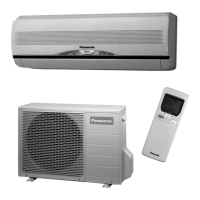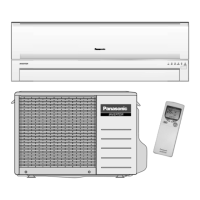Why does my Panasonic CU-VU12SKQ's outdoor unit emit water or steam?
- TTerry GarciaAug 13, 2025
The emission of water or steam from the outdoor unit of your Panasonic Air Conditioner is due to condensation or evaporation occurring on the pipes.

Why does my Panasonic CU-VU12SKQ's outdoor unit emit water or steam?
The emission of water or steam from the outdoor unit of your Panasonic Air Conditioner is due to condensation or evaporation occurring on the pipes.
Why is there dust around my Panasonic Air Conditioner?
The dust accumulation is due to the air purification effect of negative ions from nanoe-G. You can remove the dust regularly with a clean dampened cloth.
Why does my Panasonic CU-VU12SKQ make cracking sounds?
The cracking sound you hear during operation is due to changes in temperature that cause the expansion and contraction of the unit.
Why does the POWER indicator blink on my Panasonic CU-VU12SKQ Air Conditioner before I turn it on?
The blinking POWER indicator is a preliminary step in preparation for operation when the ON timer has been set.
Why is my Panasonic CU-VU12SKQ delayed when restarting?
The delay you experience when restarting your Panasonic Air Conditioner is a protection mechanism for the unit’s compressor.
Why does my Panasonic CU-VU12SKQ make a water flowing sound?
The water flowing sound you hear during operation is due to the refrigerant flow inside the unit.
Why does my Panasonic CU-VU12SKQ Air Conditioner have a peculiar odor?
The peculiar odor may be due to a damp smell emitted by the wall, carpet, furniture, or clothing in the room.
Why does the indoor fan stop occasionally on my Panasonic Air Conditioner?
The indoor fan stops occasionally during automatic fan speed setting to help remove the surrounding odour.
| Brand | Panasonic |
|---|---|
| Model | CU-VU12SKQ |
| Category | Air Conditioner |
| Language | English |
Steps for inserting batteries and setting the clock on the remote control.
How to select modes, start/stop, and set temperature for basic unit operation.
Critical safety warnings and guidelines for the indoor and outdoor air conditioner units.
Important safety measures for using the remote control and its batteries.
Essential safety rules regarding power cords, outlets, and electrical connections.
Safety protocols for installing and working with R32 refrigerant.
Steps to prevent fire hazards and ignition risks during operation and maintenance.
Procedures for checking refrigeration equipment and electrical components for safety.
Safety during repair, cabling, leak detection, and handling flammable refrigerants.
Guidelines for safe evacuation, removal, and charging of refrigerant.












